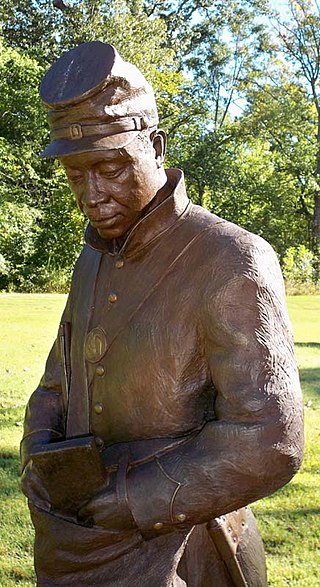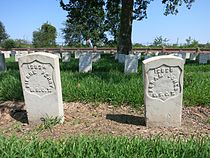
The Battle of Milliken's Bend was fought on June 7, 1863, as part of the Vicksburg Campaign during the American Civil War. Major General Ulysses S. Grant of the Union Army had placed the strategic Mississippi River city of Vicksburg, Mississippi, under siege in mid-1863. Confederate leadership erroneously believed that Grant's supply line still ran through Milliken's Bend, Louisiana, and Major General Richard Taylor was tasked with disrupting it to aid the defense of Vicksburg. Taylor sent Brigadier General Henry E. McCulloch with a brigade of Texans to attack Milliken's Bend, which was held by a brigade of newly-recruited African American soldiers. McCulloch's attack struck early on the morning of June 7, and was initially successful in close-quarters fighting. Fire from the Union gunboat USS Choctaw halted the Confederate attack, and McCulloch later withdrew after the arrival of a second gunboat. The attempt to relieve Vicksburg was unsuccessful. One of the first actions in which African American soldiers fought, Milliken's Bend demonstrated the value of African American soldiers as part of the Union Army.

The 8th Illinois Infantry Regiment was an infantry regiment that served in the Union Army during the American Civil War.
The 8th Louisiana Regiment Infantry (African Descent) was an infantry regiment in the Union Army during the American Civil War. It was composed primarily of freed or escaped slaves from Louisiana's plantations and was commanded by white officers.
The 10th Louisiana Infantry (African descent) was a regiment in the Union Army during the American Civil War. It was composed primarily of freed or escaped slaves from Louisiana's plantations and was commanded by white officers.

Hermann Lieb was a Swiss immigrant to the United States who served in the Union Army during the American Civil War. He is best remembered as the commander of the Union forces at the Battle of Milliken's Bend in 1863.
The 49th United States Colored Infantry, first established as the 11th Louisiana Infantry (African descent) was an infantry regiment in the Union Army during the American Civil War.
The 42nd Ohio Infantry Regiment was an infantry regiment in the Union Army during the American Civil War.

The 55th United States Colored Infantry Regiment was a United States Colored Troops infantry regiment in the Union Army during the American Civil War. It was first organized as the 1st Alabama Volunteer Infantry Regiment (African Descent) in May 1863, serving on garrison duty at Corinth, Mississippi and Memphis, Tennessee. It was redesignated as the 55th United States Colored Infantry in March 1864, continuing its garrison service in Tennessee and fighting at the Battle of Brices Cross Roads. After the end of the war, the regiment was mustered out in late 1865 after garrison duty in Louisiana.
The 1st Louisiana Battery Light Artillery (African Descent) was organized at Hebron's Plantation, Missouri, November 6, 1863. Attached to 1st Brigade, U.S. Colored Troops, District of Vicksburg, to April, 1864. On duty at Goodrich Landing and Vicksburg till April, 1864. Designation of Battery changed to Battery "C", 2nd U.S. Colored Light Artillery, April 26, 1864.
The 51st United States Colored Infantry Regiment was an infantry regiment composed of African-American troops recruited from Mississippi that served in the Union Army during the American Civil War. Initially formed in the spring of 1863 as the 1st Regiment Mississippi Volunteer Infantry (African Descent), the Regiment took part in fierce fighting at the Battle of Milliken's Bend, served on garrison duty in Louisiana, and then took part in the Battle of Fort Blakeley, the last major battle of the war.
The 53rd United States Colored Infantry was an infantry regiment that served in the Union Army during the American Civil War. Originally formed as the 3rd Regiment Mississippi Volunteers (African Descent), the regiment was composed of African American enlisted men commanded by white officers. The 53rd served on garrison duty in Louisiana, Mississippi, and Arkansas before being mustered out of service in 1866.

The 16th Texas Cavalry Regiment was a unit of mounted volunteers from Texas that fought in the Confederate States Army during the American Civil War. The regiment was recruited in early 1862 and mustered into Confederate service in April 1862. The unit fought as cavalry at the Battle of Cotton Plant but it was dismounted in the summer of 1862. The 16th Cavalry served as infantry in Walker's Texas Division for the remainder of the war. The regiment fought at Milliken's Bend, Mansfield, Pleasant Hill, and Jenkins' Ferry. The unit marched to Texas in early 1865 and disbanded in May 1865.

The 3rd United States Colored Cavalry was a regiment in the United States Army organized as one of the units of the United States Colored Troops during the American Civil War. The regiment was originally formed in October 1863 at Vicksburg, Mississippi as the 1st Mississippi Cavalry Regiment. The unit soon began taking part in expeditions near Vicksburg. In February–March 1864, the regiment saw action at Yazoo City. After being renamed the 3rd U.S. Colored Cavalry in March 1864, the regiment continued to participate in raids, including the Yazoo City expedition in May. In December 1864, the unit took part in a successful raid led by Benjamin Grierson during which the Battle of Egypt Station and other actions were fought. The regiment operated near Memphis, Tennessee, until April 1865, after which it returned to Vicksburg for occupation duties. The soldiers were mustered out of federal service in January 1866.

The 13th Texas Cavalry Regiment was a unit of mounted volunteers recruited in Texas that fought in the Confederate States Army during the American Civil War. The regiment was enrolled in Confederate service in February 1862 and served exclusively west of the Mississippi River. The unit was later dismounted and became part of the Texas infantry division known as Walker's Greyhounds. The regiment fought at Milliken's Bend in 1863 and Mansfield, Pleasant Hill, and Jenkins' Ferry in 1864. The regiment disbanded in May 1865, but its official surrender date was 2 June 1865.

The 18th Texas Infantry Regiment was a unit of volunteers recruited in Texas that fought in the Confederate States Army during the American Civil War. The regiment was enrolled in Confederate service in May 1862 and always campaigned west of the Mississippi River in the region known as the Trans-Mississippi Department. The unit was assigned to the Texas infantry division known as Walker's Greyhounds. The regiment fought at Milliken's Bend, Richmond (La.), and Bayou Bourbeux in 1863 and Mansfield, Pleasant Hill, and Jenkins' Ferry in 1864. The regiment disbanded in mid-May 1865, but its formal surrender date was 26 May 1865.

The 11th Texas Infantry Regiment was a unit of volunteers recruited in Texas that fought in the Confederate States Army during the American Civil War. The regiment organized in the winter of 1861–1862 and always served west of the Mississippi River in the Trans-Mississippi Department. The unit was assigned to the 2nd Brigade of the Texas infantry division known as Walker's Greyhounds. The regiment fought at Milliken's Bend and Bayou Bourbeux in 1863 and Mansfield, Pleasant Hill, and Jenkins' Ferry in 1864. The regiment disbanded in mid-May 1865, but its formal surrender date was 26 May 1865.

1st Texas Field Battery or Edgar's Company was an artillery battery from Texas that served in the Confederate States Army during the American Civil War. The artillery company formed in November 1860, but was not formally taken into Confederate service until April 1861. The unit participated in the disarming and surrender of United States soldiers and property in Texas in early 1861. The battery marched to Arkansas where in 1862 it joined the infantry division known as Walker's Greyhounds. The battery fought at Milliken's Bend and Richmond (La.), shelled a Federal river transport, and campaigned in south Louisiana in late 1863. The 1st Texas Battery was captured at Henderson's Hill in March 1864. The soldiers were later exchanged, and the unit disbanded in 1865 at the end of the conflict.

The 28th Texas Cavalry Regiment was a unit of mounted volunteers recruited in east Texas that fought in the Confederate States Army during the American Civil War. In May 1862, the regiment entered Confederate service and served the entire war west of the Mississippi River in the region known as the Trans-Mississippi Department. The unit was soon dismounted before being assigned to the 2nd Brigade of the all-Texas infantry division known as Walker's Greyhounds. In 1863, the regiment played a secondary role at Milliken's Bend. The regiment fought in three major battles during April 1864, at Mansfield, Pleasant Hill, and Jenkins' Ferry. The Trans-Mississippi Department surrendered on 26 May 1865, but the survivors dispersed to their homes before that date.
The 66th United States Colored Infantry Regiment was an infantry regiment composed of African-American troops recruited from Mississippi that served in the Union Army during the American Civil War. The 66th Regiment was posted on garrison duty in Mississippi, Louisiana, and Arkansas, and fought several skirmishes with Confederate troops around the Mississippi River before being mustered out of service in 1866.
The 4th Louisiana Native Guard Infantry Regiment was an African-American unit of the Union Army during the American Civil War. The 4th Native Guard was later redesignated as the 4th Regiment, Corps d' Afrique, and then finally as the 76th US Colored Infantry Regiment. The Regiment took part in battles at Port Hudson, Louisiana, and Fort Blakely, Alabama before being mustered out of service in December, 1865.












